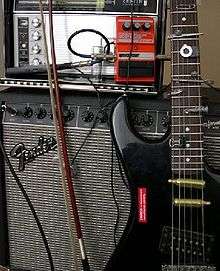Electric guitar
An electric guitar is a guitar that requires external amplification in order to be heard at typical performance volumes. It uses one or more pickups to convert the vibration of its strings into electrical signals, which ultimately are reproduced as sound by loudspeakers. The sound can be shaped or electronically altered to achieve different timbres or tonal qualities, making it quite different than an acoustic guitar. Often, this is done through the use of effects such as reverb, distortion and "overdrive"; the latter is considered to be a key element of electric blues guitar music and rock guitar playing.
 1954 Gibson Les Paul Custom electric guitar | |
| String instrument | |
|---|---|
| Other names | Guitar, solid-body guitar |
| Classification | String instrument (fingered or picked or strummed) |
| Hornbostel–Sachs classification | 321.322 (Composite chordophone) |
| Developed | 1932 |
| Playing range | |
 (a standard tuned guitar)
| |
Invented in 1932, the electric guitar was adopted by jazz guitar players, who wanted to play single-note guitar solos in large big band ensembles. Early proponents of the electric guitar on record include Les Paul, Lonnie Johnson, Sister Rosetta Tharpe, T-Bone Walker, and Charlie Christian. During the 1950s and 1960s, the electric guitar became the most important instrument in popular music.[1] It has evolved into an instrument that is capable of a multitude of sounds and styles in genres ranging from pop and rock to country music, blues and jazz. It served as a major component in the development of electric blues, rock and roll, rock music, heavy metal music and many other genres of music.
Electric guitar design and construction varies greatly in the shape of the body and the configuration of the neck, bridge, and pickups. Guitars may have a fixed bridge or a spring-loaded hinged bridge, which lets players "bend" the pitch of notes or chords up or down, or perform vibrato effects. The sound of an electric guitar can be modified by new playing techniques such as string bending, tapping, and hammering-on, using audio feedback, or slide guitar playing.
There are several types of electric guitar, including: the solid-body guitar; various types of hollow-body guitars; the six-string guitar (the most common type), which is usually tuned E, B, G, D, A, E, from highest to lowest strings; the seven-string guitar, which typically adds a low B string below the low E; the eight-string guitar, which typically adds a low E or F# string below the low B; and the twelve-string guitar, which has six pairs of strings.
In pop and rock music, the electric guitar is often used in two roles: as a rhythm guitar, which plays the chord sequences or progressions, and riffs, and sets the beat (as part of a rhythm section); and as a lead guitar, which provides instrumental melody lines, melodic instrumental fill passages, and solos. In a small group, such as a power trio, one guitarist switches between both roles. In large rock and metal bands, there is often a rhythm guitarist and a lead guitarist.
History

Many experiments at electrically amplifying the vibrations of a string instrument were made dating back to the early part of the 20th century. Patents from the 1910s show telephone transmitters were adapted and placed inside violins and banjos to amplify the sound. Hobbyists in the 1920s used carbon button microphones attached to the bridge; however, these detected vibration from the bridge on top of the instrument, resulting in a weak signal.[2] With numerous people experimenting with electrical instruments in the 1920s and early 1930s, there are many claimants to have been the first to invent an electric guitar.
Electric guitars were originally designed by acoustic guitar makers and instrument manufacturers. The demand for amplified guitars began during the big band era; as orchestras increased in size, guitar players soon realized the necessity in guitar amplification and electrification.[3] The first electric guitars used in jazz were hollow archtop acoustic guitar bodies with electromagnetic transducers. Early electric guitar manufacturers include Rickenbacker in 1932; Dobro in 1933; National, AudioVox and Volu-tone in 1934; Vega, Epiphone (Electrophone and Electar), and Gibson in 1935 and many others by 1936.
The first electrically amplified stringed instrument to be marketed commercially was designed in 1931 by George Beauchamp, the general manager of the National Guitar Corporation, with Paul Barth, who was vice president.[4] The maple body prototype for the one-piece cast aluminium "frying pan" was built by Harry Watson, factory superintendent of the National Guitar Corporation.[4] George Beauchamp, along with Adolph Rickenbacker, invented the electromagnetic pickups.[5] Coils that were wrapped around a magnet would create an electromagnetic field that amplified the vibrations of the guitar strings. Commercial production began in late summer of 1932 by the Ro-Pat-In Corporation (Electro-Patent-Instrument Company), in Los Angeles,[6][7] a partnership of Beauchamp, Adolph Rickenbacker (originally Rickenbacher), and Paul Barth.[8] In 1934, the company was renamed the Rickenbacker Electro Stringed Instrument Company. In that year Beauchamp applied for a United States patent for an Electrical Stringed Musical Instrument and the patent was later issued in 1937.[9][10][11][12] By the time it was patented, other manufacturers were already making their own electric guitar designs.[13]
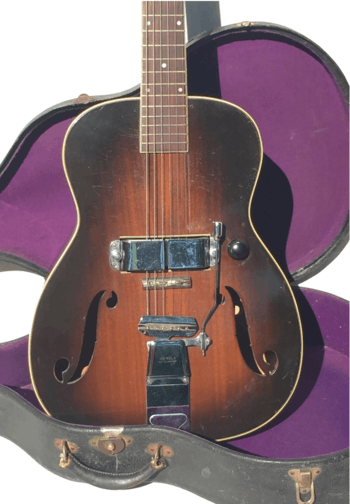
By early-mid 1935, Electro String Instrument Corporation had achieved mainstream success with the A-22 "Frying Pan" steel guitar, and set out to capture a new audience through its release of the Electro-Spanish Model B and the Electro-Spanish Ken Roberts, which was the first full 25-inch scale electric guitar ever produced.[14][9][10][11][12] The Electro-Spanish Ken Roberts was revolutionary for its time, providing players a full 25-inch scale, with easy access to 17 frets free of the body.[15] Unlike other lap-steel electrified instruments produced during the time, the Electro-Spanish Ken Roberts was designed to play standing vertical, upright with a strap.[15] The Electro-Spanish Ken Roberts was also the first instrument to feature a hand-operated vibrato as a standard appointment,[15] a device called the "Vibrola," invented by Doc Kauffman.[15] [16] It is estimated that fewer than 50 Electro-Spanish Ken Roberts were constructed between 1933 and 1937; fewer than 10 are known to survive today.[9][10][11][12]
The solid-body electric guitar is made of solid wood, without functionally resonating air spaces. The first solid-body Spanish standard guitar was offered by Vivi-Tone no later than 1934. This model featured a guitar-shaped body of a single sheet of plywood affixed to a wood frame. Another early, substantially solid Spanish electric guitar, called the Electro Spanish, was marketed by the Rickenbacker guitar company in 1935 and made of Bakelite. By 1936, the Slingerland company introduced a wooden solid-body electric model, the Slingerland Songster 401 (and a lap steel counterpart, the Songster 400).
Gibson's first production electric guitar, marketed in 1936, was the ES-150 model ("ES" for "Electric Spanish", and "150" reflecting the $150 price of the instrument, along with matching amplifier). The ES-150 guitar featured a single-coil, hexagonally shaped "bar" pickup, which was designed by Walt Fuller. It became known as the "Charlie Christian" pickup (named for the great jazz guitarist who was among the first to perform with the ES-150 guitar). The ES-150 achieved some popularity but suffered from unequal loudness across the six strings.
A functioning solid-body electric guitar was designed and built in 1940 by Les Paul from an Epiphone acoustic archtop, as an experiment. His "log guitar" — a wood post with a neck attached and two hollow-body halves attached to the sides for appearance only — shares nothing in common for design or hardware with the solid-body Gibson Les Paul, designed by Ted McCarty and introduced in 1952.
The feedback associated with amplified hollow-bodied electric guitars was understood long before Paul's "log" was created in 1940; Gage Brewer's Ro-Pat-In of 1932 had a top so heavily reinforced that it essentially functioned as a solid-body instrument.[2]
Early proponents of the electric guitar on record include Alvino Rey (Phil Spitalney Orchestra), Les Paul (Fred Waring Orchestra), George Barnes (under many aliases), Eddie Durham, Lonnie Johnson, Floyd Smith, Sister Rosetta Tharpe, Big Bill Broonzy, T-Bone Walker, George Van Eps, Charlie Christian (Benny Goodman Orchestra), Tampa Red, Memphis Minnie, and Arthur Crudup. According to jazz historian James Lincoln Collier, Floyd Smith can be credited as the first person to rig up an amplified guitar. According to Collier, "Floyd's Guitar Blues" may be the first important use of the electric guitar on record.[17]
Types
Solid-body

Unlike acoustic guitars, solid-body electric guitars have no vibrating soundboard to amplify string vibration. Instead, solid-body instruments depend on electric pickups and an amplifier (or amp) and speaker. The solid body ensures that the amplified sound reproduces the string vibration alone, thus avoiding the wolf tones and unwanted feedback[20] associated with amplified acoustic guitars. These guitars are generally made of hardwood covered with a hard polymer finish, often polyester or lacquer. In large production facilities, the wood is stored for three to six months in a wood-drying kiln before being cut to shape. Premium custom-built guitars are frequently made with much older, hand-selected wood.
One of the first solid-body guitars was invented by Les Paul. Gibson did not present their Gibson Les Paul guitar prototypes to the public, as they did not believe the solid-body style would catch on. Another early solid-body Spanish style guitar, resembling what would become Gibson's Les Paul guitar a decade later, was developed in 1941 by O.W. Appleton, of Nogales, Arizona.[21] Appleton made contact with both Gibson and Fender but was unable to sell the idea behind his "App" guitar to either company.[22] In 1946, Merle Travis commissioned steel guitar builder Paul Bigsby to build him a solid-body Spanish-style electric.[23] Bigsby delivered the guitar in 1948. The first mass-produced solid-body guitar was Fender Esquire and Fender Broadcaster (later to become the Fender Telecaster), first made in 1948, five years after Les Paul made his prototype. The Gibson Les Paul appeared soon after to compete with the Broadcaster.[24] Another notable solid-body design is the Fender Stratocaster, which was introduced in 1954 and became extremely popular among musicians in the 1960s and 1970s for its wide tonal capabilities and more comfortable ergonomics than other models.
The history of Electric Guitars is summarized by Guitar World magazine, and the earliest electric guitar on their top 10 list is the Ro-Pat-In Electro A-25 "Frying Pan" (1932) described as 'The first-fully functioning solid-body electric guitar to be manufactured and sold'.[25] The most recent electric guitar on this list is the Ibanez Jem (1987) which featured '24 frets', 'an impossibly thin neck' and was 'designed to be the ultimate shredder machine'. Numerous other important electric guitars are on the list including Gibson ES-150 (1936), Fender Telecaster (1951), Gibson Les Paul (1952), Gretsch 6128 Duo Jet (1953), Fender Stratocaster (1954), Rickenbacker 360/12 (1964), Van Halen Frankenstein (1975), Paul Reed Smith Custom (1985) many of these guitars were 'successors' to earlier designs.[25] Electric Guitar designs eventually became culturally important and visually iconic, with various model companies selling miniature model versions[26][27] of particularly famous electric guitars, for example the Gibson SG used by Angus Young from the group AC/DC.
Chambered-body
Some solid-bodied guitars, such as the Gibson Les Paul Supreme, the PRS Singlecut, and the Fender Telecaster Thinline, are built with hollow chambers in the body. These chambers are designed to not interfere with the critical bridge and string anchor point on the solid body. In the case of Gibson and PRS, these are called chambered bodies. The motivation for this may be to reduce weight, to achieve a semi-acoustic tone (see below) or both.[28][29][30]
Semi-acoustic

Semi-acoustic guitars have a hollow body (similar in depth to a solid-body guitar) and electronic pickups mounted on the body. They work in a similar way to solid-body electric guitars except that, because the hollow body also vibrates, the pickups convert a combination of string and body vibration into an electrical signal. Whereas chambered guitars are made, like solid-body guitars, from a single block of wood, semi-acoustic and full-hollowbody guitars bodies are made from thin sheets of wood. They do not provide enough acoustic volume for live performance, but they can be used unplugged for quiet practice. Semi-acoustics are noted for being able to provide a sweet, plaintive, or funky tone. They are used in many genres, including blues, funk, sixties pop, and indie rock. They generally have cello-style F-shaped sound holes. These can be blocked off to prevent feedback, as in B. B. King's famous Lucille. Feedback can also be reduced by making them with a solid block in the middle of the soundbox.
Full hollow-body
Full hollow-body guitars have large, deep bodies made of glued-together sheets, or "plates", of wood. They can often be played at the same volume as an acoustic guitar and therefore can be used unplugged at intimate gigs. They qualify as electric guitars inasmuch as they have fitted pickups. Historically, archtop guitars with retrofitted pickups were among the very earliest electric guitars. The instrument originated during the Jazz Age, in the 1920s and 1930s, and are still considered the classic jazz guitar (nicknamed "jazzbox"). Like semi-acoustic guitars, they often have f-shaped sound holes.
Having humbucker pickups (sometimes just a neck pickup) and usually strung heavily, jazzboxes are noted for their warm, rich tone. A variation with single-coil pickups, and sometimes with a Bigsby tremolo, has long been popular in country and rockabilly; it has a distinctly more twangy, biting tone than the classic jazzbox. The term archtop refers to a method of construction subtly different from the typical acoustic (or "folk" or "western" or "steel-string" guitar): the top is formed from a moderately thick (1 inch (2.5 cm)) piece of wood, which is then carved into a thin (0.1 inches (0.25 cm)) domed shape, whereas conventional acoustic guitars have a thin, flat top.
Electric acoustic
Some steel-string acoustic guitars are fitted with pickups purely as an alternative to using a separate microphone. They may also be fitted with a piezoelectric pickup under the bridge, attached to the bridge mounting plate, or with a low-mass microphone (usually a condenser mic) inside the body of the guitar that converts the vibrations in the body into electronic signals. Combinations of these types of pickups may be used, with an integral mixer/preamp/graphic equalizer. Such instruments are called electric acoustic guitars. They are regarded as acoustic guitars rather than electric guitars, because the pickups do not produce a signal directly from the vibration of the strings, but rather from the vibration of the guitar top or body.
Electric acoustic guitars should not be confused with semi-acoustic guitars, which have pickups of the type found on solid-body electric guitars, or solid-body hybrid guitars with piezoelectric pickups.
Construction
_-_with_hint_lines_and_numbers.png)
1.1 machine heads
1.2 truss rod cover
1.3 string guide
1.4 nut
2. Neck
2.1 fretboard
2.2 inlay fret markers
2.3 frets
2.4 neck joint
3. Body
3.1 "neck" pickup
3.2 "bridge" pickup
3.3 saddles
3.4 bridge
3.5 fine tuners and tailpiece assembly
3.6 whammy bar (vibrato arm)
3.7 pickup selector switch
3.8 volume and tone control knobs
3.9 output connector (output jack)(TS)
3.10 strap buttons
4. Strings
4.1 bass strings
4.2 treble strings
Electric guitar design and construction vary greatly in the shape of the body and the configuration of the neck, bridge, and pickups. However, some features are present on most guitars. The photo below shows the different parts of an electric guitar. The headstock (1) contains the metal machine heads (1.1), which use a worm gear for tuning. The nut (1.4)—a thin fret-like strip of metal, plastic, graphite or bone—supports the strings at the headstock end of the instrument. The frets (2.3) are thin metal strips that stop the string at the correct pitch when the player pushes a string against the fingerboard. The truss rod (1.2) is a metal rod (usually adjustable) that counters the tension of the strings to keep the neck straight. Position markers (2.2) provide the player with a reference to the playing position on the fingerboard.[31]
The neck and fretboard (2.1) extend from the body. At the neck joint (2.4), the neck is either glued or bolted to the body. The body (3) is typically made of wood with a hard, polymerized finish. Strings vibrating in the magnetic field of the pickups (3.1, 3.2) produce an electric current in the pickup winding that passes through the tone and volume controls (3.8) to the output jack. Some guitars have piezo pickups, in addition to or instead of magnetic pickups.
Some guitars have a fixed bridge (3.4). Others have a spring-loaded hinged bridge called a vibrato bar, tremolo bar, or whammy bar, which lets players bend notes or chords up or down in pitch or perform a vibrato embellishment. A plastic pickguard on some guitars protects the body from scratches or covers the control cavity, which holds most of the wiring. The degree to which the choice of woods and other materials in the solid-guitar body (3) affects the sonic character of the amplified signal is disputed. Many believe it is highly significant, while others think the difference between woods is subtle. In acoustic and archtop guitars, wood choices more clearly affect tone.
Woods typically used in solid-body electric guitars include alder (brighter, but well rounded), swamp ash (similar to alder, but with more pronounced highs and lows), mahogany (dark, bassy, warm), poplar (similar to alder), and basswood (very neutral).[32] Maple, a very bright tonewood,[32] is also a popular body wood, but is very heavy. For this reason it is often placed as a "cap" on a guitar made primarily of another wood. Cheaper guitars are often made of cheaper woods, such as plywood, pine or agathis—not true hardwoods—which can affect durability and tone. Though most guitars are made of wood, any material may be used. Materials such as plastic, metal, and even cardboard have been used in some instruments.
The guitar output jack typically provides a monaural signal. Many guitars with active electronics use a jack with an extra contact normally used for stereo. These guitars use the extra contact to break the ground connection to the on-board battery to preserve battery life when the guitar is unplugged. These guitars require a mono plug to close the internal switch and connect the battery to ground. Standard guitar cables use a high-impedance 1⁄4 inch (6.35 mm) mono plug. These have a tip and sleeve configuration referred to as a TS phone connector. The voltage is usually around 1 to 9 millivolts.
A few guitars feature stereo output, such as Rickenbacker guitars equipped with Rick-O-Sound. There are a variety of ways the "stereo" effect may be implemented. Commonly, but not exclusively, stereo guitars route the neck and bridge pickups to separate output buses on the guitar. A stereo cable then routes each pickup to its own signal chain or amplifier. For these applications, the most popular connector is a high-impedance 1⁄4 inch (6.35 mm) plug with a tip, ring and sleeve configuration, also known as a TRS phone connector. Some studio instruments, notably certain Gibson Les Paul models, incorporate a low-impedance three-pin XLR connector for balanced audio. Many exotic arrangements and connectors exist that support features such as midi and hexaphonic pickups.
Bridge and tailpiece systems
The bridge and tailpiece, while serving separate purposes, work closely together to affect playing style and tone. There are four basic types of bridge and tailpiece systems on electric guitars. Within these four types are many variants.
A hard-tail guitar bridge anchors the strings at or directly behind the bridge and is fastened securely to the top of the instrument.[33] These are common on carved-top guitars, such as the Gibson Les Paul and the Paul Reed Smith models, and on slab-body guitars, such as the Music Man Albert Lee and Fender guitars that are not equipped with a vibrato arm.
A floating or trapeze tailpiece (similar to a violin's) fastens to the body at the base of the guitar. These appear on Rickenbackers, Gretsches, Epiphones, a wide variety of archtop guitars, particularly Jazz guitars, and the 1952 Gibson Les Paul.[34]
Pictured is a tremolo arm or vibrato tailpiece style bridge and tailpiece system, often called a whammy bar or trem. It uses a lever ("vibrato arm") attached to the bridge that can temporarily slacken or tighten the strings to alter the pitch. A player can use this to create a vibrato or a portamento effect. Early vibrato systems were often unreliable and made the guitar go out of tune easily. They also had a limited pitch range. Later Fender designs were better, but Fender held the patent on these, so other companies used older designs for many years.
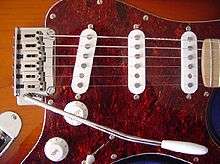
With expiration of the Fender patent on the Stratocaster-style vibrato, various improvements on this type of internal, multi-spring vibrato system are now available. Floyd Rose introduced one of the first improvements on the vibrato system in many years when, in the late 1970s, he experimented with "locking" nuts and bridges that prevent the guitar from losing tuning, even under heavy vibrato bar use.

The fourth type of system employs string-through body anchoring. The strings pass over the bridge saddles, then through holes through the top of the guitar body to the back. The strings are typically anchored in place at the back of the guitar by metal ferrules. Many believe this design improves a guitar's sustain and timbre. A few examples of string-through body guitars are the Fender Telecaster Thinline, the Fender Telecaster Deluxe, the B.C. Rich IT Warlock and Mockingbird, and the Schecter Omen 6 and 7 series.
Pickups
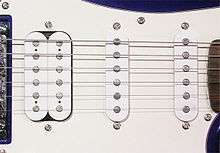
Compared to an acoustic guitar, which has a hollow body, electric guitars make much less audible sound when their strings are plucked, so electric guitars are normally plugged into a guitar amplifier and speaker. When an electric guitar is played, string movement produces a signal by generating (i.e., inducing) a small electric current in the magnetic pickups, which are magnets wound with coils of very fine wire. The signal passes through the tone and volume circuits to the output jack, and through a cable to an amplifier.[35] The current induced is proportional to such factors as string density and the amount of movement over the pickups.
Because of their natural inductive qualities, magnetic pickups tend to pick up ambient, usually unwanted electromagnetic interference or EMI.[36] This mains hum results in a tone of 50 or 60 cycles per second depending on the powerline frequency of the local alternating current supply.
The resulting hum is particularly strong with single-coil pickups. Double-coil or "humbucker" pickups were invented as a way to reduce or counter the sound. The high combined inductance of the two coils also leads to the richer, "fatter" tone associated with humbucking pickups.
Guitar necks
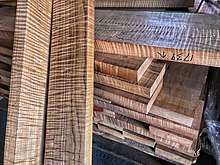
Electric guitar necks vary in composition and shape. The primary metric of guitar necks is the scale length, which is the vibrating length of the strings from nut to bridge. A typical Fender guitar uses a 25.5-inch (65 cm) scale length, while Gibson uses a 24.75-inch (62.9 cm) scale length in their Les Paul. While the scale length of the Les Paul is often described as 24.75 inches, it has varied through the years by as much as a half inch.[37]
Frets are positioned proportionally to scale length—the shorter the scale length, the closer the fret spacing. Opinions vary regarding the effect of scale length on tone and feel. Popular opinion holds that longer scale length contributes to greater amplitude. Reports of playing feel are greatly complicated by the many factors involved in this perception. String gauge and design, neck construction and relief, guitar setup, playing style and other factors contribute to the subjective impression of playability or feel.
_neck_joint_plate.jpg)
Necks are described as bolt-on, set-in, or neck-through, depending on how they attach to the body. Set-in necks are glued to the body in the factory. This is the traditional type of joint. Leo Fender pioneered bolt-on necks on electric guitars to facilitate easy adjustment and replacement. Neck-through instruments extend the neck the length of the instrument, so that it forms the center of the body. While a set-in neck can be carefully unglued by a skilled luthier, and a bolt-on neck can simply be unscrewed, a neck-through design is difficult or even impossible to repair, depending on the damage. Historically, the bolt-on style has been more popular for ease of installation and adjustment. Since bolt-on necks can be easily removed, there is an after-market in replacement bolt-on necks from companies such as Warmoth and Mighty Mite. Some instruments—notably most Gibson models—continue to use set-in glued necks. Neck-through bodies are somewhat more common in bass guitars.
Materials for necks are selected for dimensional stability and rigidity[38], and some allege that they influence tone. Hardwoods are preferred, with maple, mahogany, and ash topping the list. The neck and fingerboard can be made from different materials; for example, a guitar may have a maple neck with a rosewood or ebony fingerboard. In the 1970s, designers began to use exotic man-made materials such as aircraft-grade aluminum, carbon fiber, and ebonol. Makers known for these unusual materials include John Veleno, Travis Bean, Geoff Gould, and Alembic.
Aside from possible engineering advantages, some feel that in relation to the rising cost of rare tonewoods, man-made materials may be economically preferable and more ecologically sensitive. However, wood remains popular in production instruments, though sometimes in conjunction with new materials. Vigier guitars, for example, use a wooden neck reinforced by embedding a light, carbon fiber rod in place of the usual heavier steel bar or adjustable steel truss rod. After-market necks made entirely from carbon fiber fit existing bolt-on instruments. Few, if any, extensive formal investigations have been widely published that confirm or refute claims over the effects of different woods or materials on electric guitar sound.
Several neck shapes appear on guitars, including shapes known as C necks, U necks, and V necks. These refer to the cross-sectional shape of the neck (especially near the nut). Several sizes of fret wire are available, with traditional players often preferring thin frets, and metal shredders liking thick frets. Thin frets are considered better for playing chords, while thick frets allow lead guitarists to bend notes with less effort.
An electric guitar with a folding neck called the "Foldaxe" was designed and built for Chet Atkins by Roger C. Field.[39] Steinberger guitars developed a line of exotic, carbon fiber instruments without headstocks, with tuning done on the bridge instead.
Fingerboards vary as much as necks. The fingerboard surface usually has a cross-sectional radius that is optimized to accommodate finger movement for different playing techniques. Fingerboard radius typically ranges from nearly flat (a very large radius) to radically arched (a small radius). The vintage Fender Telecaster, for example, has a typical small radius of approximately 7.25 inches (18.4 cm). Some manufacturers have experimented with fret profile and material, fret layout, number of frets, and modifications of the fingerboard surface for various reasons. Some innovations were intended to improve playability by ergonomic means, such as Warmoth Guitars' compound radius fingerboard. Scalloped fingerboards added enhanced microtonality during fast legato runs. Fanned frets intend to provide each string with an optimal playing tension and enhanced musicality. Some guitars have no frets—and others, like the Gittler guitar, have no neck in the traditional sense.
Sound and effects
While an acoustic guitar's sound depends largely on the vibration of the guitar's body and the air inside it, the sound of an electric guitar depends largely on the signal from the pickups. The signal can be "shaped" on its path to the amplifier via a range of effect devices or circuits that modify the tone and characteristics of the signal. Amplifiers and speakers also add coloration to the final sound.
Built-in sound shaping
Modern electric guitars most commonly have two or three magnetic pickups. Identical pickups produce different tones depending on location between the neck and bridge. Bridge pickups produce a bright or trebly timbre (i.e. more high frequency content), and neck pickups are warmer or more bassy (i.e. more fundamental frequency content).[40] The type of pickup also affects tone. The sound of dual-coil pickups is often described as warm and thick[41]; conversely, single-coil pickups are often described as sounding clear and bright[41].
Where there is more than one pickup, a switch selects between the outputs of individual pickups or some combination; two-pickup guitars have three-way switches, and three-pickup guitars have five-way switches. Further circuitry sometimes combines pickups in different ways. For instance, phase switching places one pickup out of phase with the other(s), resulting in destructive interference of lower-frequency harmonics (a sound often described as "thin" or "hollow"[42]). A pickup's timbre can be altered by making changes to the individual pickup's circuit. One such alteration is coil splitting, in which one coil of a humbucker pickup is removed from the circuit in order to produce a tone similar to a single-coil pickup[43] (this switching is often accomplished using push-pull potentiometers).
The final stages of on-board sound-shaping circuitry are the volume control (potentiometer) and tone control (a low-pass filter which "rolls off" the treble frequencies). Where there are individual volume controls for different pickups, and where pickup signals can be combined, they would affect the timbre of the final sound by adjusting the balance between pickups from a straight 50:50.
Guitar amplifier
The solid-body electric guitar does not produce enough sound for an audience to hear it in a performance setting unless it's electronically amplified—plugged into an amplifier, mixing console, or PA.
Guitar amplifier design uses a different approach than sound reinforcement system power amplifiers and home "hi-fi" stereo systems. Audio amplifiers generally are intended to accurately reproduce the source signal without adding unwanted tonal coloration (i.e., they have a flat frequency response) or unwanted distortion. In contrast, most guitar amplifiers provide tonal coloration and overdrive or distortion of various types. A common tonal coloration sought by guitarists is rolling off some of the high frequencies.
Guitar amplifiers generally incorporate at least a few effects, the most basic being tone controls for bass and treble. There may be some form of "overdrive" control, where the preamplifier's output is increased to the point where the amplitude overloads the input of the power amplifier stage, causing clipping.
Effects units
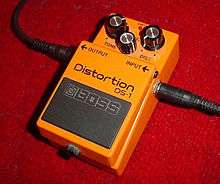
In the 1960s, the tonal palette of the electric guitar was further modified by introducing effect units in the signal path before the amplifier.
Effects units have been created in several formats, the most common of which are the stompbox "pedal" and the rackmount unit. A stomp box (or pedal) is a small metal or plastic box containing the circuitry, which is placed on the floor in front of the musician, and is activated by one or more switches intended to be pressed with the foot. Pedals are smaller than rackmount effects. A rackmount effects unit may contain an electronic circuit nearly identical to a stompbox-based effect, but cased to be mounted in a standard equipment rack. Rack-mount effects units often contain several types of effect. They are controlled by knobs or switches on the front panel or by a MIDI digital control interface.
Typical effects include:
- Effects such as stereo chorus, phasers and flangers, which shift the pitch of the signal by a small and varying amount, creating swirling, shimmering and whooshing noises
- Effects such as octavers, which displace pitch by an exact musical interval
- Distortion, such as transistor-style fuzz, effects incorporating, emulating vacuum tube distortion or overdrive
- Filters, such as wah-wah
- Envelope shapers, such as compression/sustain or volume/swell
- Time-shift effects, such as delay and reverb
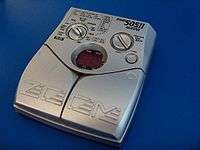
A multi-effects device is a single electronics effects pedal or rack-mount device that contains many electronic effects. Most of these devices allow users to use "pre-set" their desired combinations of effects, offering the ability to easily alter the guitar's tonal dynamics, even mid-song. Some multi-FX pedals contain modelled versions of well-known effects pedals or amplifiers.

By the 1990s, software effects became capable of digitally replicating the analog effects used in the past, with varying degrees of quality.
Synthesizer and digital guitars
Playing techniques
The sound of a guitar can not only be adapted by electronic sound effects but is also heavily affected by various new techniques developed or becoming possible in combination with electric amplification. This is called extended technique.
Many techniques, such as axial finger vibrato, pull-offs, hammer-ons, palm muting, harmonics and altered tunings, are also used on the classical and acoustic guitar. Shred guitar is a genre involving a number of extended techniques.
See also
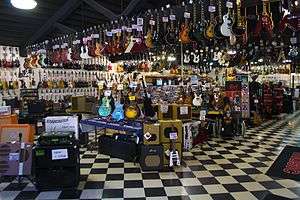
- List of electric guitar brands
- Bass guitar
- Bahian guitar
- Distortion (guitar)
- Effects pedal
- Electric pipa
- Electromagnetic induction
- Electronic tuner
- Guitar harmonics
- Guitar synthesizer
- Guitar amplifier
- Keytar
- List of guitars
- Pickup
- Sitarla
- Stars and Their Guitars: A History of the Electric Guitar (documentary film)
- Vintage guitar
References
- Hempstead, Colin; Worthington, William E. (2005). Encyclopedia of 20th-Century Technology, Volume 2. Taylor & Francis. p. 793. ISBN 1-57958-464-0.
- Wheelwright, Lynn; Carter, Walter (28 April 2010). . Vintage Guitar. Retrieved 10 July 2014.
- Center, Lemelson. "Invention: Electric Guitar". www.invention.si.edu. Lemelson Center for the Study of Invention and Innovation. Archived from the original on 24 August 2018. Retrieved 21 July 2018.
- Wheeler, Tom (1978). The Guitar Book: A Handbook for Electric & Acoustic Guitarists. Harpercollins. p. 153. ISBN 0-06-014579-X.
- April 18; 2014. "Invention". Lemelson Center for the Study of Invention and Innovation. Retrieved 8 December 2019.CS1 maint: numeric names: authors list (link)
- Smith, Richard R. (1987). The History of Rickenbacker Guitars. Centerstream Publications. p. 10. ISBN 978-0-931759-15-4.
- "Guitar E – berichte und fotos". viewgoods.de. Archived from the original on 25 October 2011. Retrieved 18 May 2011.
- Evans, Tom (1977). Guitars: Music, History, Construction and Players from the Renaissance to Rock. Paddington Press. p. 344. ISBN 0-448-22240-X.
- Editorial, Retrofret. "An Important and Historical Instrument". Retrofret Vintage Guitars. Retrofret. Retrieved 16 March 2017.
- Corporation, Richenbacker International. "The Earliest Days of the Electric Guitar". Rickenbacker. RIC. Retrieved 8 August 2015.
- USPTO, USPTO. "Stringed Instrument (Tremolo)". Google Patents. USPTO. Retrieved 8 August 2016.
- USPTO, USPTO. "Electric Stringed Musical Instrument". google.patents. USPTO. Retrieved 8 August 2016.
- Kreiser, Christine (April 2015). "American History". Electric Guitar. 50: 16 – via MasterFILE Complete.
- Maloof, Rich. "Who Really Invented the Electric Guitar". Reverb.com. Reverb.com. Retrieved 21 July 2018.
- Writer, Staff. "Rickenbacker Ken Roberts Model Hollow Body Electric Guitar". Retrofret.com. Retrofret.com. Retrieved 21 July 2018.
- USPTO, USPTO. "Apparatus for producing tremolo effects". US Patent Trade Mark Office. USPTO. Retrieved 21 July 2018.
- James Lincoln Collier, The Making of Jazz: A Complete History, Dell, 1978,
- D'arcy, David (12 November 2000). "ART/ARCHITECTURE; Strummed by One Hand, Sculptured by Another". The New York Times. Retrieved 2 May 2010.
- Ed Mitchell (Total Guitar) (28 December 2011). "IN PRAISE OF: The Fender Stratocaster | IN PRAISE OF: The Fender Stratocaster". MusicRadar. Retrieved 14 December 2013.
- Mottola, R.M. (1 January 2020). Mottola's Cyclopedic Dictionary of Lutherie Terms. LiutaioMottola.com. p. 58. ISBN 978-1-7341256-0-3.
- "O. W. Appleton Home Page". Worldwide Filmworks. 2012. Retrieved 25 July 2013.
- Wheeler, Tom (1982). American Guitars: An Illustrated History. Harper & Row. p. 8. ISBN 0060149965.
- Ross, Michael. "Forgotten Heroes: Paul Bigsby". Premier Guitar. Retrieved 19 October 2015.
- Ratcliffe, Alan (2005) Electric Guitar Handbook, UK: New Holland Publishers, p. 11. ISBN 1-84537-042-2.
- "Guitar World Magazine Tolinkski and Di Perna". 2017. Retrieved 17 April 2018.
- "Companies selling Models of Guitars". 2018. Retrieved 17 April 2018.
- "Companies selling Models of Guitars 2". 2018. Retrieved 17 April 2018.
- Hunter, Dave (19 October 2007) Chambering the Les Paul: A Marriage of Weight and Tone. Gibson Lifestyle
- "Does my Les Paul have weight relief holes or sound chambers?". lespaulforum.com.
- Irizarry, Rob (5 March 2007) Making Electric Guitars That Won't Break Your Back. Building the Ergonomic Guitar.
- Bartolo, Joel Di. Serious Electric Bass: The Bass Player's Complete Guide to Scales and Chords. Alfred Music. p. 7. ISBN 1457460963. Retrieved 26 July 2015.
- Warmoth Custom Guitars, (retrieved 16 December 2013)
- Hunter, Dave (2006). The Electric Guitar Sourcebook: How to Find the Sounds You Like (1. ed.). San Francisco: Backbeat. p. 20. ISBN 0879308869.
- "Electric Guitar (Les Paul model) by Gibson, Inc., Kalamazoo, 1952". Orgs.usd.edu. Retrieved 8 November 2012.
- Vassilis Lembessis, Dr. (1 July 2001). "Physics... in action". Europhysics News. 32 (4): 125–125. doi:10.1051/epn:2001402. ISSN 0531-7479.
- Lemme, Helmuth. "The Secrets of Electric Guitar Pickups" (PDF). Build Your Guitar. Electronic Musician. Retrieved 15 April 2016.
- "Scale Length Explained". StewMac. Retrieved 24 July 2019.
- "Roasted Maple: Guitar Neck Wood Guide". Commercialforestproducts.com. 22 September 2019.
- Cochran, Russ and Atkins, Chet (2003). Chet Atkins: Me and My Guitars, Hal Leonard, p. 124, ISBN 0-634-05565-8.
- Donaldson, Nicholas. "An Electric Guitar Plucked String Model for Realtime Control with Distortion and Feedback". McGill University. Retrieved 24 July 2019.
- Dunn, Matt title. "All the Types of Electric Guitar Pickups Explained & Compared". StringJoy. Retrieved 24 July 2019.
- Perkins, Matt. "Pickup Polarity and Phase Made Simple". Seymour Duncan. Retrieved 24 July 2019.
- Corfield, Chris. "How do coil tap & split coil pickups work?". Dawsons Music. Retrieved 24 July 2019.
Sources
- Broadbent, Peter (1997). Charlie Christian: Solo Flight – The Seminal Electric Guitarist. Ashley Mark Publishing Company. ISBN 1-872639-56-9.
External links
| Wikimedia Commons has media related to Electric guitars. |
- ON! The Beginnings of Electric Sound Generation – an exhibit at the Museum of Making Music, National Association of Music Merchants, Carlsbad, CA – some of the earliest electric guitars and their history, from the collection of Lynn Wheelwright and others
- King of Kays Vintage guitar's from America, Japan, and Italy. Pictures, history, and forums.
- The Invention of the Electric Guitar – Online exhibition at the Smithsonian Institution's National Museum of American History
